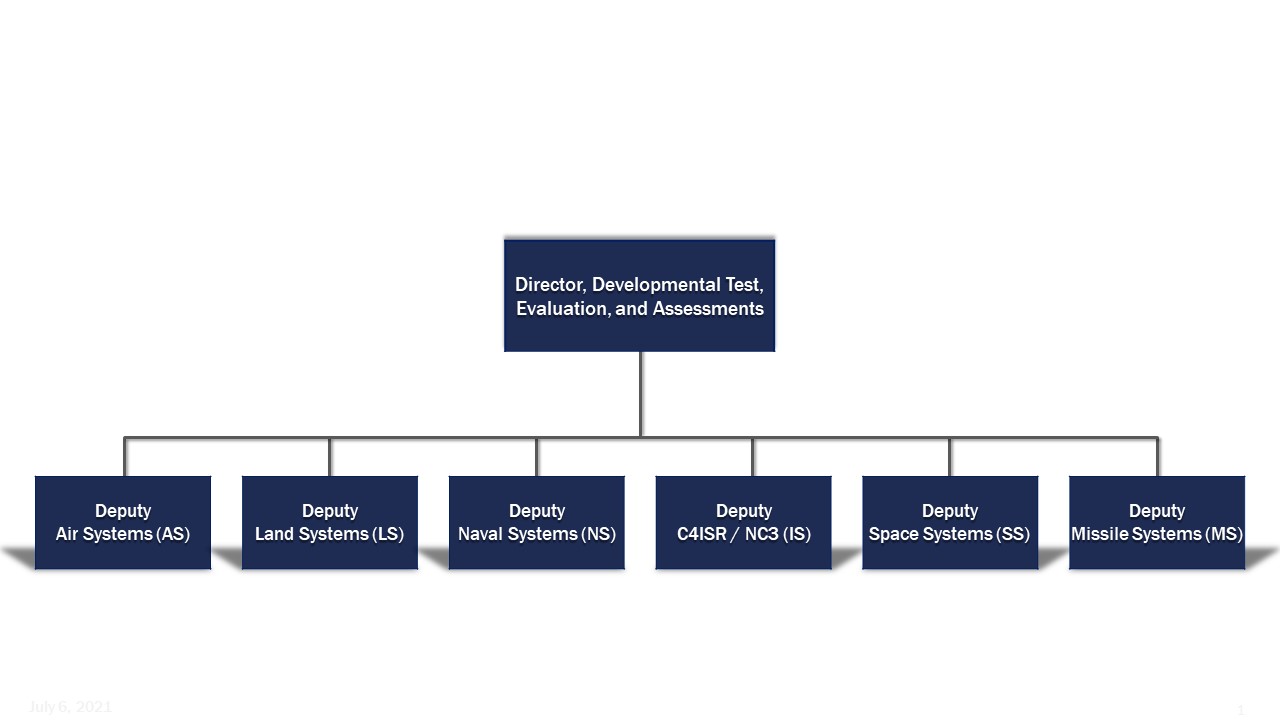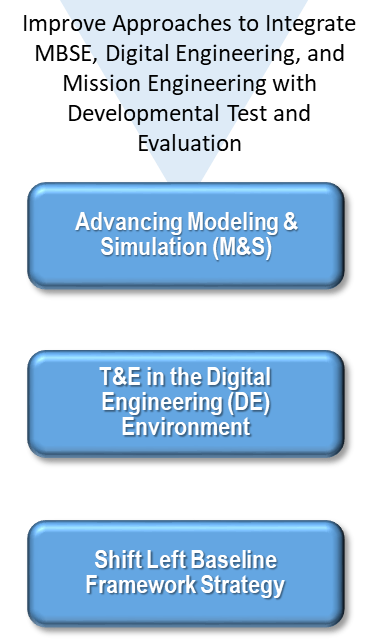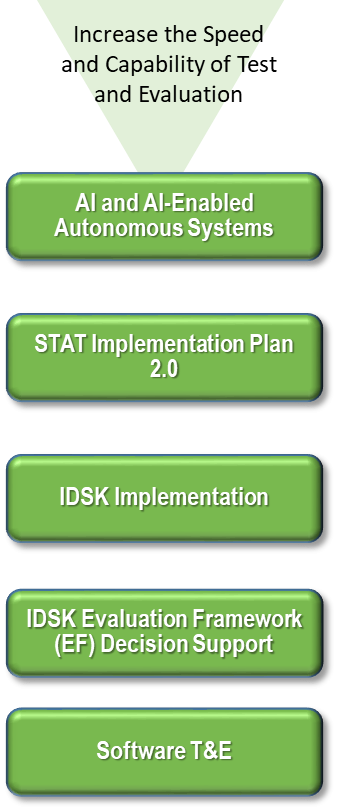
About the Office of Developmental Test,
Evaluation, and Assessments
About the Office of Developmental Test, Evaluation, and Assessments
About the Office of Developmental Test, Evaluation, and Assessments
The Office of the Director for Developmental Test, Evaluation, and Assessments (DTE&A) is responsible for the Systems Engineering and Developmental Testing roles and responsibilities within the office of the Deputy Director for Engineering (DD, ENG).
DTE&A activities are an inherent part of the DoD's systems engineering verification and validation process that enables rapid system development, from concept to delivery, of relevant capability within the Adaptive Acquisition Framework pathways. DTE&A also maintains close collaboration with the activities of DD, ENG Specialty Engineering
Lines of Effort
DTE&A Lines of Effort link multiple key tasks within each effort using the logic of purpose - cause and effect - to help organize and focus our work toward achieving the DTE&A mission. DTE&A Lines of Effort align with USD(R&E) modernization priorities and strategic needs.
Deputies
-
DTE&A Chief Engineer (CHENG)
CHENG: Mr. Orlando Flores
-
Air Systems (AS)
Deputy: Mr. Jim Bierstine
-
Land Systems (LS)
Acting Deputy: Mr. Jim Alexander
-
C4ISR/NC3 Systems (C4ISR/NC3)
Deputy: Ms. Robbyn Berenda
-
Naval Systems (NS)
Deputy: Mr. Wil Mullen
-
Space Systems (SS)
Deputy: Mr. Rick Thomas
-
Missile Systems (MS)
Deputy: Mr. Steven Lopes
D(DTE&A) Organizational Structure

Test and Evaluation New Paradigm
In coordination with the Director, Operational Test and Evaluation (DOT&E), we are shifting the current DoD Test and Evaluation (T&E) paradigm away from the serial contractor test, developmental test (DT), and operational test (OT) sequence to support the DoD Adaptive Acquisition Framework (AAF) pathways.
Areas of Emphasis
In FY22, DTE&A efforts emphasize three areas with specific planned outcomes:
- Increase the Speed and Capability of Test and Evaluation.
- Outcome: Deliver test and evaluation methodologies, analytic techniques, and capabilities to address new USD(R&E) technology areas to improve decision making and rapidly field warfighter capabilities.
- Improve Approaches to Integrate Model-Based Systems Engineering (MBSE), Digital Engineering (DE), and Mission Engineering (ME) with Developmental Test and Evaluation (DT&E).
- Outcome: Deliver an integrated portfolio of targeted, shift left best-practices, processes, and collaborative engagement strategies across the MBSE, DE, and ME community to improve workforce development and engineering rigor to better support tech transition.
- Shift Cyber Testing Earlier in Program Development Focusing on Cybersecurity Resilience.
- Outcome: Advance modernization of integrated cyber T&E tools, processes, engineering, and workforce development enabling implementation of continuous cyber T&E to accelerate maturity of critical operational warfighting capabilities' survivability and operational resilience against the full spectrum of cyber threats.
DTE&A Initiatives Framework
DTE&A FY22 Initiatives are embedded and linked to a specific Area of Emphasis. Each Initiative has a designated Project Integrator (PI) responsible for managing the specific projects and deliverables for that effort.
Improving T&E Integration Approaches

Advancing Modeling and Simulation
- Provide a coordinated framework for growing Modeling and Simulation (M&S) capabilities and resources to enhance M&S procedures for early testing and prototyping efforts, across the Adaptive Acquisition Pathways.
T&E in the Digital Engineering Environment
- Advance DE in enabling streamlined, automated, model‐centric T&E processes in a DE ecosystem through improved guidance, tools, and collaboration to support implementation of Digital Engineering concepts and methodologies.
Shift Left Baseline Framework Strategy
- Identify key "Shift Left" practices and policy modifications for early and efficient testing, enabling programs to maximize test data as soon as possible and inform program development decisions.
Increasing the Speed and Capability of T&E

Artificial Intelligence (AI) and AI-Enabled Autonomous Systems
- Develop and enable T&E tools and techniques for AI-enabled defense systems to be matured and more widely applied across DoD; advance T&E of AI- enabled systems to rapidly field critical capabilities fully informed of their risks and rewards.
Integrated Decision Support Key (IDSK) Evaluation Framework (EF) Implementation
- Mature the IDSK EF and corresponding guidance to guide AAF programs' evaluation of operational and technical capabilities, drawing upon data from the full test continuum to inform acquisition and operational decisions.
IDSK EF Decision Support
- Provide a rigorous, repeatable, and systematic capability evaluation approach using ME results combined with the T&E decision-supporting EF concept to inform Prototyping and Experimentation's (P&E) recommendations to operationalize systems and facilitate rapid modernization and transition into programs of record.
STAT Implementation Plan 2.0
- Transform how the DoD plans and conducts T&E to a more scientifically rigorous method to improve system behavior and combat mission capability data across the DoD to improve test execution, reduce program burden, and improve data-informed acquisition decisions.
Software T&E
- Provide guidance to the T&E defense acquisition community regarding execution of DevSecOps T&E within a DoD environment, resulting in speed of delivery to the warfighter and increased quality.
Shifting Cyber Testing Earlier in Program Development

Cyber Mission and Threat
- Mature and expand consistent application of Objective Quality Evidence-based T&E processes, Mission-Based Cyber Risk Assessments, and evaluation frameworks, using mission-based testing objectives over the T&E continuum, to demonstrate direct correlation of operational mission impacts to system survivability and resilience from the full spectrum of cyber threat effects.
Cyber Analytic Tools
- Increase applicability, consistency, efficiency, effectiveness, accuracy, and repeatability of risk assessments. Improve cyber requirements and risk representation using digital engineering and MBSE. Improve maturity, efficacy of cyber risk identification, quantification, remediation, and mitigation tools and methods across the T&E continuum.
Cyber Engineering and Contracts
- Improve contractor accountability for testable, measurable, and achievable cyber requirements throughout the program to verify that networks, systems, and information are survivable and resilient to cyber threats.

ASD(MC)
Assistant Secretary of Defense for Mission Capabilities
The Pentagon, Washington, DC 20301
Contact Us
Information for ASD(MC): Contact OUSD(R&E) Staff
Social Media: @DoDCTO on Twitter
For website issues: Contact Webmaster